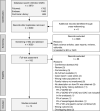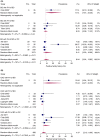Systematic review with meta-analysis: the effects of family history on the risk of Barrett's oesophagus and oesophageal adenocarcinoma
- PMID: 34383966
- PMCID: PMC9292032
- DOI: 10.1111/apt.16558
Systematic review with meta-analysis: the effects of family history on the risk of Barrett's oesophagus and oesophageal adenocarcinoma
Abstract
Background: Current guidelines recommend different screening approaches for individuals with a family history of Barrett's oesophagus (BO) or oesophageal adenocarcinoma (OAC), varying from no screening to screening all individuals with a positive family history.
Aims: To determine evidence-based risk estimates for individuals with a family history of BO or OAC METHODS: We systematically searched Pubmed, Embase and Cochrane Library until October 2020 to identify all studies that reported on the association between family history and the risk of BO and OAC. Pooled summary estimates of adjusted relative risks and prevalence of familial BO/OAC with 95% confidence intervals (CIs) were calculated using a random effects model.
Results: Fourteen studies comprising 16 189 BO/OAC patients were analysed. Familial clustering was seen in 8.84% (95% CI: 5.54-13.82) and 4.37% (95% CI: 2.15-8.69) of patients with BO and OAC, respectively (nine studies). Screening first-degree relatives of BO patients had a diagnostic yield between 12% and 44% for BO (four studies). However, the yield for high-grade dysplasia and OAC was low (<2%). Individuals with a positive family history had a higher risk of having BO (aRR 3.26; 95% CI 1.43-7.40; I2 = 46%; three studies) and OAC (aRR 2.19; 95% CI 1.14-4.21; I2 = 48%; five studies) compared to individuals without a family history.
Conclusions: A verified family history of BO or OAC is a strong risk factor for both BO and OAC. A positive family history could be a clinically meaningful way to identify high-risk individuals who may benefit from early detection strategies.
© 2021 The Authors. Alimentary Pharmacology & Therapeutics published by John Wiley & Sons Ltd.
Figures



References
-
- Arnold M, Laversanne M, Brown LM, et al. Predicting the future burden of esophageal cancer by histological subtype: international trends in incidence up to 2030. Am J Gastroenterol. 2017;112:1247‐1255. - PubMed
-
- Arnold M, Ferlay J, van Berge Henegouwen MI, et al. Global burden of oesophageal and gastric cancer by histology and subsite in 2018. Gut. 2020;69:1564. - PubMed
-
- van Putten M, de Vos‐Geelen J, Nieuwenhuijzen GAP, et al. Long‐term survival improvement in oesophageal cancer in the Netherlands. Eur J Cancer. 2018;94:138‐147. - PubMed
-
- Hvid‐Jensen F, Pedersen L, Drewes AM, et al. Incidence of adenocarcinoma among patients with Barrett's esophagus. N Engl J Med. 2011;365:1375‐1383. - PubMed
Publication types
MeSH terms
LinkOut - more resources
Full Text Sources
Medical
